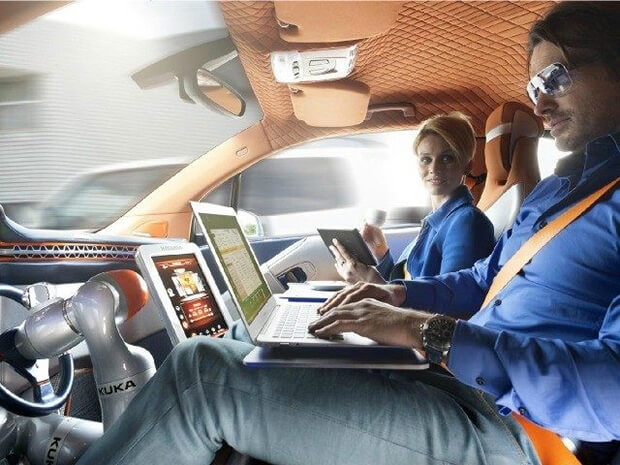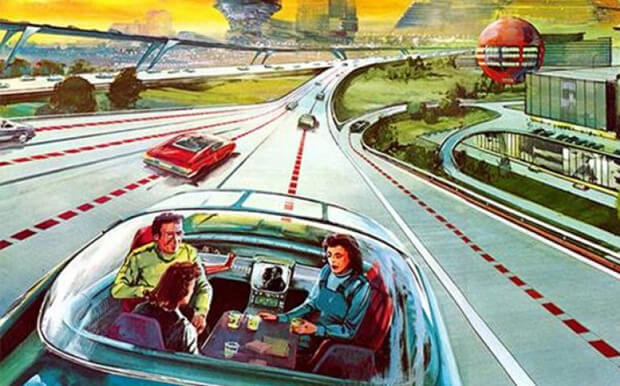The next media revolution looks likely to come from driverless cars

The next media revolution looks likely to come from driverless cars
Who'll want to listen to the radio when you could play Gran Turismo in the car?
Whether we like it or not, driverless cars are here to stay and within a decade we will see a huge impact on the motor industry with the introduction of autonomous vehicles.
As the world’s road safety experts and infrastructure specialists brace themselves for the coming upheaval in traditional methods of infrastructure planning, the long anticipated media revolution is also approaching rapidly.
With the advent of the ‘third living space’ in your car, the way we consume entertainment on the go is going to also change drastically and some giants stand to lose as a result.
Integrated music streaming services are already representing a serious threat to drive-time radio stations, as easily-connected smartphones can offer motorists and passengers self-selected playlists and music they actually want, rather than music chosen for them.
Driverless cars will only increase the potential for the demise of radio drive-time many times over, for one simple reason: instead of just listening, drivers and passengers will finally be able to watch a video and play games while their autonomous vehicle chauffeurs them to their destination.
The American car manufacturer, Ford has gone as far as patenting an “autonomous vehicle entertainment system’ which will effectively replace the visible windscreen with a projector screen, where a driver and passengers can totally ignore the road.
Ford earlier this year announced a partnership with Amazon’s Alexa and in the future people in the car won’t even have to move to pause their chosen show. The line between the driver, passenger and audience will be blurred beyond recognition.
Will we even have the expression driver in the future as most vehicles will be totally safe and autonomous?
The future driver or whatever designation we will call them at that time will be able to divert their full attention away from the road and concentrate on their entertainment and communication systems.

When one considers the implications of driverless vehicles, it’s easy to see why radio stations, for example, might worry about their place in the entertainment equation.
The up and coming generation is growing up seeing radio as less useful than Spotify and video on demand could, in turn, overtake music streaming in cars.
Streaming platforms now provide, “pick up where you left off” services across multiple devices, so entertainment in a driverless vehicle will be seamless from home, commute to our place of work and back again.
Such technological integrations are not overly complex challenges and if radio will be challenged by video, both of these will be threatened by gaming.
The heavy emphasis on portability and adaptability presented by the Nintendo Switch indicates yet more prescience by the Japanese giants. Cars with built-in console docks are a logical extension of the iPod adaptors and in-car DVD players of yore. Drivers could be speeding round the Nürburgring in Gran Turismo or throwing blue shells in Mario Kart, all while being driven around by a computer.
In the future, when passengers look out of the window, they may view an augmented reality as these technologies will be integrated with heads up display technology.
It could mean the car could interpret a giant QR code in 3D on a billboard or floating in the sky and use it to display a targeted advertisement.
These developments will represent major opportunities for growth and profit for the early adopting companies that develop the integrated entertainment and infomercial technologies.
In the future, many big-data companies will have available to them rich datasets, generated by the scale of this interconnectivity of activity which will have huge commercial value.
They will, for example, be able to find out important information on their customers and users. For example, will motorists prefer short shows when driving in cities compared to rural routes? Will documentaries be favoured over dramas by 4x4 owners, or puzzle games preferred to first person shooters by still other techno-savvy drivers? All will become clear in the near future but one thing is for sure, a few fortunate companies will hugely benefit from the future of these entertainment and communication data pools.
Connected and autonomous cars do not have a ceiling in terms of potential at the moment; from shared lounges in limousines, to utterly immersive mobile virtual reality stations and independently travelling bookable meeting spaces, the sky's the limit.
The new technological horizon will be rife with opportunity for innovation and profit as industries compete for an in-car audience that was previously almost entirely dedicated to radio and music.
(As always, if you or a family member are considering buying a used car, don’t buy until you run a car check report with MyVehicle.ie where you will find out the true history of the vehicle.)

Author

Justin Kavanagh
Justin Kavanagh is a recognised leader
in automotive intelligence and vehicle
data supply to the entire motor industry.
He has almost 20 years experience in
building systems from the ground up.
As the Managing Director of Vehicle
Management System, he understands the
need and importance of trustworthy and
reliable vehicle history and advice to
both the trade and the public.
Follow me on LinkedIn